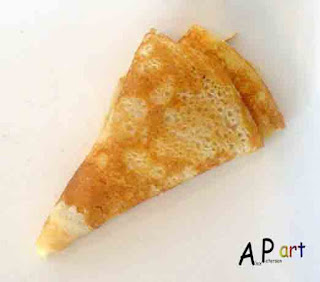I love the multiplicity in which a crepe can be folded, filled and served being savoury or sweet crepes. Crepes can be folded or shaped according to any recipe directions or the cook's desire. It essentially comes down to preference; however here are a few of my ideas.
No fold: Place the crepe with the first cooked side up displaying the nice lace pattern. Place filling on the crepe which is always eaten with a knife and fork.
Folded in half: Place the crepe with the first cooked side down and place filling in half of the crepe. Fold the crepe over in half and displays the nice lace pattern of the crepe. It is best eaten with a knife and fork.


Folded in three: Place the crepe with the first cooked side down and place a line of filling in the middle of the crepe. Fold the right side past the middle and then do the same with the left. This crepe shows the filling at the ends and is usually eaten with a fork.
Folded in four: Place the crepe with the first cooked side down and place a line of filling in the middle of the crepe. Fold the right side past the middle and then do the same with the left. Fold over the bottom and top. This crepe is usually eaten by hand.
Folded in triangles: Place the crepe with the first cooked side down and place filling on half the crepe. Fold the crepe in half and then in half again. This method is generally used for restaurant desserts such as Crepe Suzette and is usually eaten with a knife and fork.
Rolled: Place the crepe with the first cooked side down and place a line of filling in the middle or at the end of the crepe. Roll the crepe and display the lace pattern. This crepe is usually used for dessert with a topping such as icing sugar, cocoa powder or chocolate and is typically eaten on a plate with a knife and fork. If it is a thin layer of filling such as jam or sugar the crepe can be eaten by hand.
Layered Gateau: Place a crepe on a plate followed by spreading a filling and placing another crepe on top. Continue this process until the gateau is tall enough and the last crepe displays the lace pattern. This cake can be cut in slices and eaten with a knife and fork or by hand.
Fold and roll: Place the crepe with the first cooked side down and place a line of filling in the middle of the crepe. Fold the two opposite ends over approx. 3 cm. Roll the crepe over from the open end until it is completely rolled up. This crepe is both eaten by hand or with a knife and fork.
Cut in half and folded in a cone shape: Place the crepe with the first cooked side down and cut in half. Arrange filling from the middle of the crepe in a triangle towards the top. Roll into a cone shape, this crepe is typically eaten on a plate with a knife and fork.
Cone shaped: Place the crepe with the first cooked side down and position filling from the middle of the crepe in a triangle towards the top. Fold the crepe in half and roll into a cone shape. It can be eaten by hand or on a plate with a knife and fork.
Rolled and cut in strips: Place the crepe with the first cooked side down and roll the crepe like a cigar. Cut into thin strips and unfold. These strips of crepes can be is used to garnish or paired with a savoury and dessert dish.
Crepe basket: Fold a crepe over a mold and cook in a 200ºC oven for approx. 10 minutes until dry enough to hold a filling.
Deep Fried Crepe: Take a cold crepe and fry in the deep fryer for approx 3 minutes until crispy but still can be molded. Place the crepe folded on a stick and allow cooling before sifting icing sugar on top. This crispy crepe is eaten as it is by hand or as part of a dessert plate with a knife and fork.
Open Envelope fold: Place the crepe with the first cooked side down and place a filling in the middle of the crepe. Fold the two opposite side ends over approx. 3 cm. Fold the crepe up from the bottom 5 cm. This crepe is both eaten by hand or with a knife and fork.
Note: There is probably more ways to enjoy a crepe folded or molded. One trendy take away crepe to enjoy is Japanese street crepe which is folded with your preferred filling and folded in a cone shape with surrounded paper.














No comments:
Post a Comment